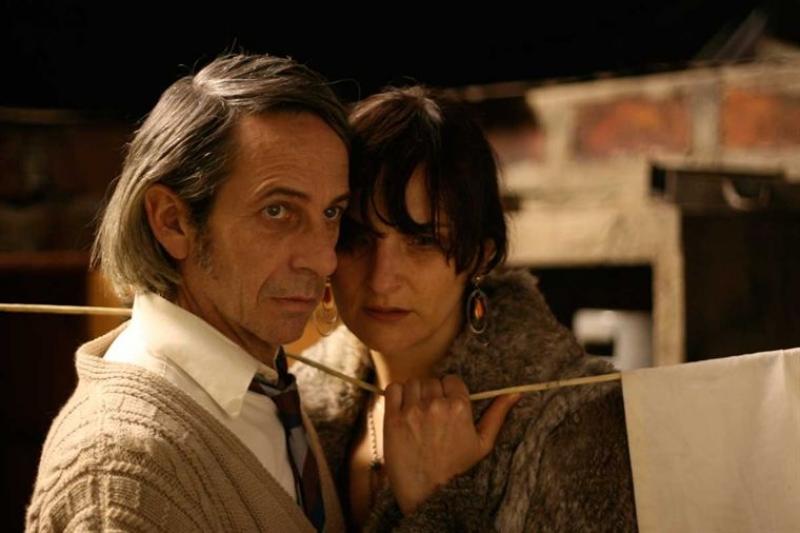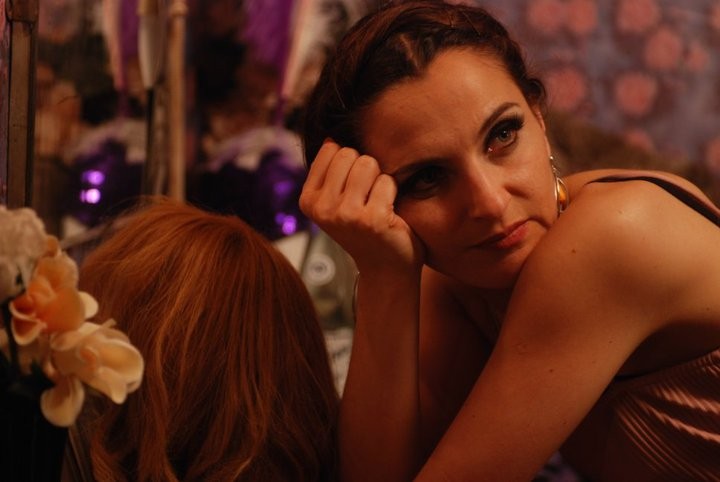Post Mortem | reviews, news & interviews
Post Mortem
Post Mortem
A remarkably original film examines the aftermath of Allende's suspicious death

Post Mortem is Chilean Pablo Larraín’s follow-up to the extraordinary Tony Manero, and another, even tougher take on his country’s troubled past. While the first film was a blackly comic look at the dictatorship years of the Seventies, this one deals with the coup itself. It’s a harrowing experience, but one that confirms Larrain as a major talent.
The customary device for viewing atrocity is through the experience of ordinary people; indeed, the film that heralded the recent renaissance in Chilean cinema, Machuca, showed the military overthrow of Allende’s government and its aftermath through the eyes of children, innocents who feel the full force of the physical and emotional violence. Larraín bucks this trend, with a colder, much more challenging approach.
The central character of Tony Manero was a psychopathic disco dancer, obsessed with John Travolta’s white-tuxedo-clad character from Saturday Night Fever, who stalked the desolate streets of Santiago in search of (and prepared to kill for) glass bricks for his perfect disco dance floor. This wholly unsympathetic man, oblivious to the repression around him, represented the ways in which Larrain believed the dictatorship was affecting the humanity and future economic ethos of his country.
 The central figure of Post Mortem may not be such a monster, but he is no less strange. Mario Cornejo works as a coroner’s assistant in a Santiago hospital, his job to annotate the coroner’s findings during autopsy, and later type the report. As played by Tony Manero star Alfredo Castro (pictured right), Mario is the kind of person whose presence seems more like an absence, who with his lank hair and tiny, weedy voice, his innate diffidence, disappears the moment he walks into a room.
The central figure of Post Mortem may not be such a monster, but he is no less strange. Mario Cornejo works as a coroner’s assistant in a Santiago hospital, his job to annotate the coroner’s findings during autopsy, and later type the report. As played by Tony Manero star Alfredo Castro (pictured right), Mario is the kind of person whose presence seems more like an absence, who with his lank hair and tiny, weedy voice, his innate diffidence, disappears the moment he walks into a room.
When the film starts, trouble is brewing on the streets, but the lonely Mario has something else on his mind: Nancy (Antonia Zegers, pictured below), an anorexic dancer in a down-at-heel cabaret, who lives across the street. On the day that Nancy is fired, Mario goes backstage to court her. They start a decidedly ill-matched relationship, Nancy seeming able to take or leave her suitor, as her mood suits.
Their first date epitomises the film’s absurdist veneer (one that suits the horrors to come). Mario calls on Nancy at her house, where her communist family and friends are holding a meeting. She crosses the street to his suitably bland home, where he cooks her a disgusting meal of rice and grease-soaked fried egg. Over the meal, she bursts into unexplained tears; he pauses, then joins her with his own weeping; and then the film cuts to the pair having emotionless, slightly crazed sex.
 However marginal they may be, when Pinochet’s soldiers start their slaughter the man from the mortuary and the woman with communist connections are suddenly very central to the action. And their experience is chilling. Mario is in the shower as tanks rumble into his street. When he leaves his house, it is into a war zone; by the time he arrives at work, the hospital corridors are full of soldiers and dead bodies. The coroner has his work cut out for him. But one body in particular will test him and his colleagues to the full: that of Salvador Allende.
However marginal they may be, when Pinochet’s soldiers start their slaughter the man from the mortuary and the woman with communist connections are suddenly very central to the action. And their experience is chilling. Mario is in the shower as tanks rumble into his street. When he leaves his house, it is into a war zone; by the time he arrives at work, the hospital corridors are full of soldiers and dead bodies. The coroner has his work cut out for him. But one body in particular will test him and his colleagues to the full: that of Salvador Allende.
The manner in which Chile’s Socialist president died, and the question of whether he was killed or committed suicide, has divided Chileans ever since the coup. Larraín uses the actual autopsy notes to recreate his film’s central and most conventionally moving scene. To Chileans in the audience it may be hard to bear.
Typically of Larraín’s humour, Mario’s only dilemma in this moment is how to use his new electric typewriter. Otherwise, he alone amongst the staff seems unmoved. Indeed, when a captain says, “Congratulations. You now serve the Chilean army,” he responds with a sickly-sweet smile, suggesting that in the moment of his country’s worst nightmare the outsider suddenly feels at home.
That said, Larraín and his actor mine numerous nuances in Mario’s reaction to his new environment. If the first half of the film was a black comedy, the second half is intensely dramatic, as Mario is forced to make a number of moral decisions, in particular when he finds, amongst the new corpses, a man who is still alive, and when he discovers Nancy hiding in the ruins of her house with her communist boyfriend, and demanding help.
Using old Russian camera lenses (apparently favoured by Tarkovsky), Larraín’s look for the film is as jaundiced as his characters. The paleness of the image creates a sense that we are, literally, looking in on the past, and on people who will soon become numbed, nullified by the horror they have faced. If Mario and Nancy, two people who have been living in their own little worlds, are atypical before the coup, the suggestion is that they will be much more typical from here on.
The film’s final scene is Larraín’s own, shocking coup de théâtre, a metaphor for the way in which Chile was about to start burying its dirty secrets. It’s a stunning ending to a remarkably original film.
Add comment
The future of Arts Journalism
You can stop theartsdesk.com closing!
We urgently need financing to survive. Our fundraising drive has thus far raised £49,000 but we need to reach £100,000 or we will be forced to close. Please contribute here: https://gofund.me/c3f6033d
And if you can forward this information to anyone who might assist, we’d be grateful.

Subscribe to theartsdesk.com
Thank you for continuing to read our work on theartsdesk.com. For unlimited access to every article in its entirety, including our archive of more than 15,000 pieces, we're asking for £5 per month or £40 per year. We feel it's a very good deal, and hope you do too.
To take a subscription now simply click here.
And if you're looking for that extra gift for a friend or family member, why not treat them to a theartsdesk.com gift subscription?
more Film
 The Mastermind review - another slim but nourishing slice of Americana from Kelly Reichardt
Josh O'Connor is perfect casting as a cocky middle-class American adrift in the 1970s
The Mastermind review - another slim but nourishing slice of Americana from Kelly Reichardt
Josh O'Connor is perfect casting as a cocky middle-class American adrift in the 1970s
 Springsteen: Deliver Me From Nowhere review - the story of the Boss who isn't boss of his own head
A brooding trip on the Bruce Springsteen highway of hard knocks
Springsteen: Deliver Me From Nowhere review - the story of the Boss who isn't boss of his own head
A brooding trip on the Bruce Springsteen highway of hard knocks
 The Perfect Neighbor, Netflix review - Florida found-footage documentary is a harrowing watch
Sundance winner chronicles a death that should have been prevented
The Perfect Neighbor, Netflix review - Florida found-footage documentary is a harrowing watch
Sundance winner chronicles a death that should have been prevented
 Blu-ray: Le Quai des Brumes
Love twinkles in the gloom of Marcel Carné’s fogbound French poetic realist classic
Blu-ray: Le Quai des Brumes
Love twinkles in the gloom of Marcel Carné’s fogbound French poetic realist classic
 Frankenstein review - the Prometheus of the charnel house
Guillermo del Toro is fitfully inspired, but often lost in long-held ambitions
Frankenstein review - the Prometheus of the charnel house
Guillermo del Toro is fitfully inspired, but often lost in long-held ambitions
 London Film Festival 2025 - a Korean masterclass in black comedy and a Camus classic effectively realised
New films from Park Chan-wook, Gianfranco Rosi, François Ozon, Ildikó Enyedi and more
London Film Festival 2025 - a Korean masterclass in black comedy and a Camus classic effectively realised
New films from Park Chan-wook, Gianfranco Rosi, François Ozon, Ildikó Enyedi and more
 After the Hunt review - muddled #MeToo provocation
Julia Roberts excels despite misfiring drama
After the Hunt review - muddled #MeToo provocation
Julia Roberts excels despite misfiring drama
 London Film Festival 2025 - Bradley Cooper channels John Bishop, the Boss goes to Nebraska, and a French pandemic
... not to mention Kristen Stewart's directing debut and a punchy prison drama
London Film Festival 2025 - Bradley Cooper channels John Bishop, the Boss goes to Nebraska, and a French pandemic
... not to mention Kristen Stewart's directing debut and a punchy prison drama
 Ballad of a Small Player review - Colin Farrell's all in as a gambler down on his luck
Conclave director Edward Berger swaps the Vatican for Asia's sin city
Ballad of a Small Player review - Colin Farrell's all in as a gambler down on his luck
Conclave director Edward Berger swaps the Vatican for Asia's sin city
 London Film Festival 2025 - from paranoia in Brazil and Iran, to light relief in New York and Tuscany
'Jay Kelly' disappoints, 'It Was Just an Accident' doesn't
London Film Festival 2025 - from paranoia in Brazil and Iran, to light relief in New York and Tuscany
'Jay Kelly' disappoints, 'It Was Just an Accident' doesn't
 Iron Ladies review - working-class heroines of the Miners' Strike
Documentary salutes the staunch women who fought Thatcher's pit closures
Iron Ladies review - working-class heroines of the Miners' Strike
Documentary salutes the staunch women who fought Thatcher's pit closures
 Blu-ray: The Man in the White Suit
Ealing Studios' prescient black comedy, as sharp as ever
Blu-ray: The Man in the White Suit
Ealing Studios' prescient black comedy, as sharp as ever

Comments
I had hoped this film would